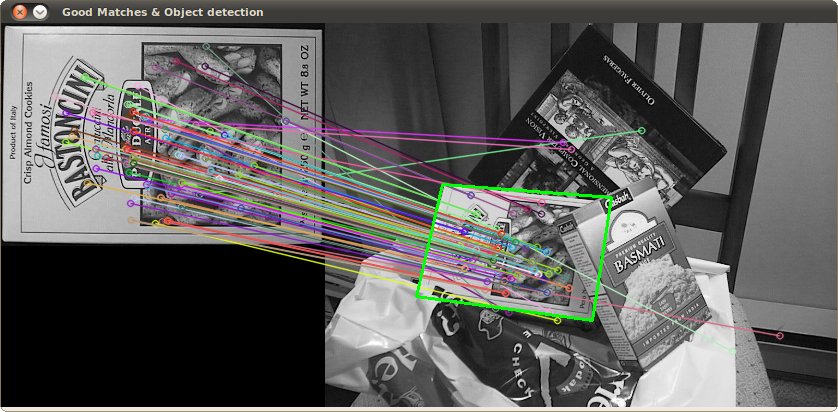Features2D + Homography to find a known object
Goal
In this tutorial you will learn how to:
- Use the function cv::findHomography to find the transform between matched keypoints.
- Use the function cv::perspectiveTransform to map the points.
Theory
Code
This tutorial code’s is shown lines below.
#include <stdio.h> #include <iostream> #include "opencv2/core.hpp" #include "opencv2/imgproc.hpp" #include "opencv2/features2d.hpp" #include "opencv2/highgui.hpp" #include "opencv2/calib3d.hpp" #include "opencv2/xfeatures2d.hpp" using namespace cv; using namespace cv::xfeatures2d; void readme(); /* @function main */ int main( int argc, char** argv ) { if( argc != 3 ) { readme(); return -1; } Mat img_object = imread( argv[1], IMREAD_GRAYSCALE ); Mat img_scene = imread( argv[2], IMREAD_GRAYSCALE ); if( !img_object.data || !img_scene.data ) { std::cout<< " --(!) Error reading images " << std::endl; return -1; } //-- Step 1: Detect the keypoints and extract descriptors using SURF int minHessian = 400; Ptr<SURF> detector = SURF::create( minHessian ); std::vector<KeyPoint> keypoints_object, keypoints_scene; Mat descriptors_object, descriptors_scene; detector->detectAndCompute( img_object, Mat(), keypoints_object, descriptors_object ); detector->detectAndCompute( img_scene, Mat(), keypoints_scene, descriptors_scene ); //-- Step 2: Matching descriptor vectors using FLANN matcher FlannBasedMatcher matcher; std::vector< DMatch > matches; matcher.match( descriptors_object, descriptors_scene, matches ); double max_dist = 0; double min_dist = 100; //-- Quick calculation of max and min distances between keypoints for( int i = 0; i < descriptors_object.rows; i++ ) { double dist = matches[i].distance; if( dist < min_dist ) min_dist = dist; if( dist > max_dist ) max_dist = dist; } printf("-- Max dist : %f \n", max_dist ); printf("-- Min dist : %f \n", min_dist ); //-- Draw only "good" matches (i.e. whose distance is less than 3*min_dist ) std::vector< DMatch > good_matches; for( int i = 0; i < descriptors_object.rows; i++ ) { if( matches[i].distance <= 3*min_dist ) { good_matches.push_back( matches[i]); } } Mat img_matches; drawMatches( img_object, keypoints_object, img_scene, keypoints_scene, good_matches, img_matches, Scalar::all(-1), Scalar::all(-1), std::vector<char>(), DrawMatchesFlags::NOT_DRAW_SINGLE_POINTS ); //-- Localize the object std::vector<Point2f> obj; std::vector<Point2f> scene; for( size_t i = 0; i < good_matches.size(); i++ ) { //-- Get the keypoints from the good matches obj.push_back( keypoints_object[ good_matches[i].queryIdx ].pt ); scene.push_back( keypoints_scene[ good_matches[i].trainIdx ].pt ); } Mat H = findHomography( obj, scene, RANSAC ); //-- Get the corners from the image_1 ( the object to be "detected" ) std::vector<Point2f> obj_corners(4); obj_corners[0] = cvPoint(0,0); obj_corners[1] = cvPoint( img_object.cols, 0 ); obj_corners[2] = cvPoint( img_object.cols, img_object.rows ); obj_corners[3] = cvPoint( 0, img_object.rows ); std::vector<Point2f> scene_corners(4); perspectiveTransform( obj_corners, scene_corners, H); //-- Draw lines between the corners (the mapped object in the scene - image_2 ) line( img_matches, scene_corners[0] + Point2f( img_object.cols, 0), scene_corners[1] + Point2f( img_object.cols, 0), Scalar(0, 255, 0), 4 ); line( img_matches, scene_corners[1] + Point2f( img_object.cols, 0), scene_corners[2] + Point2f( img_object.cols, 0), Scalar( 0, 255, 0), 4 ); line( img_matches, scene_corners[2] + Point2f( img_object.cols, 0), scene_corners[3] + Point2f( img_object.cols, 0), Scalar( 0, 255, 0), 4 ); line( img_matches, scene_corners[3] + Point2f( img_object.cols, 0), scene_corners[0] + Point2f( img_object.cols, 0), Scalar( 0, 255, 0), 4 ); //-- Show detected matches imshow( "Good Matches & Object detection", img_matches ); waitKey(0); return 0; } /* @function readme */ void readme() { std::cout << " Usage: ./SURF_descriptor <img1> <img2>" << std::endl; }
Explanation
Result
And here is the result for the detected object (highlighted in green)
